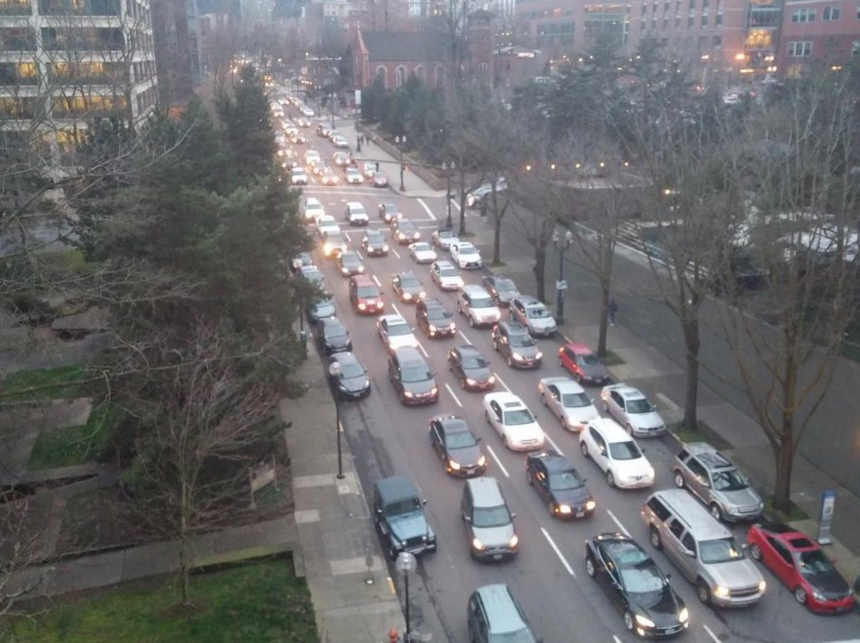Written by Gerald Fittipaldi
PSU was recently named a Platinum Bicycle Friendly University by the League of American Bicyclists. Only four other universities in the U.S. have this distinction.
As students hop off their bikes as they arrive on campus, they are met with an abundance of outdoor bike parking, secure indoor bike parking with lockers, a campus bike shop including repair stands and tools for student use, the VikeBike rental program and showers for bicycle commuters.
Ian Stude and the entire group at Transportation & Parking Services, PSU’s Bicycle Program Coordinator Clint Culpepper, and the Bike Hub all deserve a round of applause. All of these facilities are welcomed and are the reason why many students, faculty and staff are commuting to campus by bicycle.
Portland is also fortunate to have a dedicated bicycle coordinator, Roger Geller, as well as neighborhood greenway guru, Greg Raisman. They are two of Portland’s many experts who have dedicated countless hours toward planning and designing bicycle facilities.
That’s the good news. There’s just one problem: Biking on the streets leading to and from campus can be terrifying.
Seasoned bicycle commuters and those who happen to feel comfortable biking with heavy car traffic may not mind biking on downtown streets, but for the rest of the PSU community, a lingering fear of getting hit by a car is enough to make the idea of biking to campus a nonstarter.
Part of the reason for this fear is that downtown Portland has very few bike lanes, and many of the ones that do exist are very narrow and located next to parked cars. Broadway is a good example of this. The scarcity of bike lanes near PSU is so bad that there isn’t a single northbound bike lane anywhere connecting to campus. Fourth Avenue, Sixth Avenue, the Park Blocks and 10th Avenue all lack any sort of bicycle facilities.
Even for the fearless, moving through traffic on a bicycle during evening rush hour either means squeezing between cars stuck in gridlock traffic or waiting patiently behind an exhaust pipe only to crawl forward at about the pace of a person on foot.
Don’t get me wrong: Much of Portland is great for biking. The neighborhood greenway systems in Southeast and Northeast Portland, as well as bicycle-friendly bridges such as the Hawthorne Bridge and the Steel Bridge are superb. I have traveled throughout the U.S., and these neighborhood facilities are better than any others I have biked on in America. Once entering downtown, however, the scene is quite different.
Even Mayor Charlie Hales, while on a bike ride with city staffers and advocates, felt compelled to dismount his bike and walk on the sidewalk as soon as he pedaled into downtown. Portland has been moving at a glacial pace in this regard for the past several years. Three years ago, the city was awarded a $6.6 million grant for a downtown multi-modal safety project that was to be largely focused on building separated bike facilities in the downtown area.
According to a May 6 article on the Bike Portland blog, the public outreach process for this project “has yet to even start.” Roger Geller is now saying that it will probably be another two years before anything gets built.
This slow implementation lies in stark contrast to what is happening in many other cities across the country. Seattle, Chicago, Boston, New York and Washington, D.C. are among places that are steamrolling forward in removing parking and travel lanes to install separated bike lanes through the hearts of their respective downtown areas.
Just as it is necessary to have complete networks for automobiles and transit systems, it is crucial that bicycle networks be connected and safe. Portland’s politicians and decision makers need to know just how much a connected network of separated bike lanes through downtown would benefit PSU.
We currently have over 28,000 students, most of whom are commuters. A comfortable bike network would be the tipping point to entice many students to bike rather than drive to campus, contributing to a more livable downtown.
There are many ways that the public can make a difference. In the early 1970s, bicycle advocates at PSU played a large role in helping pass the historic Bicycle Bill, which to this day requires that 1 percent of funding be directed to the inclusion of facilities for pedestrians and bicyclists wherever a road, street or highway is being constructed in Oregon. This bill passed by only one vote after many students and faculty at PSU became engaged.
Last year, my classmates and I came together to form Bike PSU, a student advocacy group. Since forming we have testified at City Hall and attended multiple Downtown Neighborhood Association meetings to voice our support for improved biking conditions.
To help Bike PSU continue its momentum we need more students to get involved.
Gerald is a graduate civil engineering student and the president of Bike PSU. He can be reached at bikepsu@pdx.edu or through the organization’s Facebook group.





